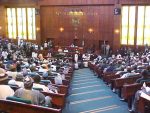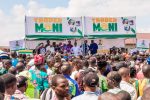10 Biggest Protests In History Of Nigeria


Nigeria, Africa’s most populous country, has a rich history of political activism and protest. These movements have often been sparked by various issues, including demands for independence, calls for democratic governance, opposition to economic policies, and campaigns for social justice.
Over the decades, the country has witnessed numerous large-scale protests that have shaped its political and social landscape. From the pre-independence era to the present day, these demonstrations have brought together millions of Nigerians in a unified voice, demanding change and accountability from their leaders.
Protests in Nigeria have often reflected the broader struggles and aspirations of its people.
The colonial period, marked by the quest for self-determination, saw significant mobilisation against British rule.
Post-independence, the country’s turbulent journey through military dictatorships and attempts at democratic governance continued to fuel the spirit of resistance. Economic challenges, human rights abuses, and social inequalities have consistently been at the forefront of the grievances leading to these protests.
The scale and impact of these protests vary, but many have left an indelible mark on Nigeria’s history. Some have led to significant political changes, while others have highlighted the persistent issues that continue to affect the nation. The resilience and determination of Nigerian protesters have been a testament to the country’s enduring spirit of activism and hope for a better future.
Here, we examine ten of the most significant protests in Nigeria’s history, each representing a pivotal moment in the nation’s ongoing struggle for justice, equity, and good governance.
1. Aba Women’s Riot (1929)
The Aba Women’s Riot, also known as the Women’s War, was a significant anti-colonial protest led by women in southeastern Nigeria.
This movement was primarily a response to the introduction of direct taxation and the disregard for traditional female leadership roles by the British colonial administration. Over 10,000 women participated in the protest, making it one of the largest and most organised demonstrations of the time.
The women’s grievances extended beyond taxation; they also opposed the corrupt practices of warrant chiefs, who were seen as colonial puppets. The protest involved strategic sit-ins, roadblocks, and attacks on colonial institutions, effectively paralysing the administrative machinery in the region. The British response was brutal, with colonial troops deployed to suppress the uprising, resulting in the deaths of approximately 50 women and the injury of many more.
The Aba Women’s Riot had lasting implications. It forced the colonial administration to reconsider its policies and led to significant reforms, including the abolition of warrant chiefdoms and a more inclusive approach to local governance. This protest not only highlighted the power of collective action but also underscored the pivotal role of women in the struggle for justice and equality in Nigeria.
The legacy of the Aba Women’s Riot continues to inspire contemporary movements, reminding Nigerians of the importance of unity and resilience in the face of oppression. It remains a powerful symbol of resistance and a testament to the enduring spirit of the country’s women in the fight for their rights and dignity.
2. The Nigerian General Strike (1945)
The Nigerian General Strike of 1945 was a watershed moment in the country’s labour movement. Led by the Trade Union Congress of Nigeria, the strike was a response to the harsh economic conditions and low wages experienced by Nigerian workers during and after World War II.
The widespread discontent culminated in a nationwide strike that lasted for 45 days, involving approximately 200,000 workers from various sectors.
The strike paralysed economic activities and significantly disrupted colonial administration. The workers’ demands included higher wages, better working conditions, and the right to form independent trade unions. Despite the initial resistance from the colonial government, the persistence of the strikers and the broad support they received from the public forced the administration to negotiate.
Ultimately, the strike led to wage increases and improved working conditions for many Nigerian workers. It also strengthened the labour movement in Nigeria, paving the way for future collective bargaining and political activism. The 1945 strike demonstrated the power of organised labour and set a precedent for subsequent industrial actions in the country.
This general strike remains a significant event in Nigeria’s history, highlighting the critical role of labour unions in advocating for workers’ rights and influencing economic policies. It also underscored the importance of solidarity and collective action in achieving social and economic justice.
3. The Anti-SAP Protests (1989)
The Anti-Structural Adjustment Programme (SAP) protests of 1989 were a direct response to the economic policies imposed by the International Monetary Fund (IMF) and the World Bank on Nigeria. These policies, adopted by the military government of General Ibrahim Babangida, aimed at economic restructuring but resulted in severe austerity measures, including subsidy cuts, wage freezes, and devaluation of the naira.
The harsh economic realities led to widespread dissatisfaction and sparked large-scale protests across the country.
University students, labour unions, and civil society groups were at the forefront of the protests. The demonstrations were marked by marches, sit-ins, and confrontations with security forces. In several instances, the protests turned violent, leading to clashes that resulted in casualties and widespread arrests. The government’s heavy-handed response, including the use of tear gas and live ammunition, drew international condemnation.
The Anti-SAP protests forced the Babangida regime to reconsider some of its policies, leading to partial reversals and modifications of the SAP measures. Although the protests did not completely halt the implementation of the SAP, they highlighted the public’s capacity to challenge unpopular economic policies and hold the government accountable.
The Anti-SAP protests are a crucial chapter in Nigeria’s history, demonstrating the power of collective action in the face of economic injustice. They underscored the importance of public participation in economic policy decisions and the need for government transparency and responsiveness to the people’s needs.
4. The June 12 Protests (1993)
The June 12 Protests were triggered by the annulment of the June 12, 1993, presidential election, which was widely regarded as the freest and fairest election in Nigeria’s history. The election, won by Moshood Abiola of the Social Democratic Party (SDP), was annulled by the military regime of General Ibrahim Babangida, leading to widespread outrage and protests across the country.
Nigerians from all walks of life, including students, activists, and political groups, took to the streets demanding the restoration of Abiola’s mandate and the end of military rule. The protests were characterised by mass rallies, civil disobedience, and general strikes. The government’s response was brutal, with security forces employing excessive force to quell the demonstrations, resulting in numerous deaths and injuries.
The June 12 Protests marked a turning point in Nigeria’s struggle for democracy. The persistent public pressure eventually led to the resignation of General Babangida and the installation of an interim national government. However, the struggle continued, culminating in the eventual transition to civilian rule in 1999.
The June 12 Protests are remembered as a pivotal moment in Nigeria’s democratic journey, symbolising the people’s unwavering demand for free and fair elections and accountable governance. They highlight the crucial role of citizen activism in challenging authoritarian rule and advancing democratic principles.
5. The Occupy Nigeria Movement (2012)
The Occupy Nigeria movement of January 2012 was one of the largest and most significant protests in the country’s recent history. It was sparked by the government’s decision to remove fuel subsidies, which led to a sudden and steep increase in the price of petrol. The decision, announced on New Year’s Day, triggered widespread outrage and protests across the nation.
The movement saw millions of Nigerians, including labour unions, civil society organisations, and ordinary citizens, take to the streets in protest.
The demonstrations were marked by mass rallies, sit-ins, and street blockades. Social media played a crucial role in mobilising and coordinating the protests, with the hashtag #OccupyNigeria becoming a rallying cry for the movement.
The government’s response included deploying security forces to disperse protesters, resulting in clashes that led to casualties. Despite this, the protests continued for over a week, paralysing economic activities and drawing international attention. The overwhelming public pressure eventually forced the government to partially reinstate the subsidy, leading to a reduction in fuel prices.
The Occupy Nigeria movement highlighted the power of collective action and social media in mobilising public sentiment and effecting policy change. It also underscored the deep-seated issues of corruption and mismanagement in the country’s governance.
The movement remains a significant example of citizen activism in Nigeria’s contemporary history.
6. The #BringBackOurGirls Movement (2014)
The #BringBackOurGirls movement emerged in response to the abduction of 276 schoolgirls by the terrorist group Boko Haram from Chibok, Borno State, in April 2014. The kidnapping sparked global outrage and led to widespread protests across Nigeria, demanding the rescue of the girls and accountability from the government.
The movement was characterised by daily sit-ins, marches, and vigils. Social media played a pivotal role in amplifying the campaign, with the hashtag #BringBackOurGirls gaining international traction and support from global figures, including former U.S. First Lady Michelle Obama. The protests highlighted the government’s inadequate response to the abduction and broader issues of security and human rights in Nigeria.
Despite the government’s initial reluctance to engage with the movement, the sustained pressure led to increased international involvement and efforts to rescue the girls. Over the years, some of the abducted girls have been released or escaped, but many remain unaccounted for.
The #BringBackOurGirls movement demonstrated the power of grassroots activism and social media in mobilising global support for a local cause. It also brought attention to the broader issues of terrorism, gender-based violence, and government accountability in Nigeria.
7. The EndSARS Protests (2020)
The EndSARS protests of October 2020 were a significant nationwide movement against police brutality in Nigeria, particularly focusing on the notorious Special Anti-Robbery Squad (SARS). The protests were sparked by numerous reports of extrajudicial killings, harassment, and extortion by SARS officers. The tipping point came when a video showing the alleged killing of a young man by SARS operatives went viral on social media, igniting widespread outrage.
The protests quickly spread across major cities, with thousands of young Nigerians taking to the streets to demand the disbandment of SARS and broader police reforms. The movement was largely youth-led, with social media playing a crucial role in organising and amplifying the protests. The hashtag #EndSARS became a global trend, drawing attention from international celebrities, activists, and politicians who expressed solidarity with the protesters.
Despite the peaceful nature of the demonstrations, the government’s response was heavy-handed. Security forces were deployed to disperse protesters, often using tear gas and live ammunition.
The most notable incident was the Lekki Toll Gate shooting on October 20, 2020, where armed soldiers allegedly opened fire on unarmed protesters, resulting in numerous casualties.
The incident sparked widespread condemnation and further intensified the protests. The EndSARS movement succeeded in getting the government to announce the dissolution of SARS and the initiation of police reforms. However, many protesters remained sceptical, demanding tangible actions and accountability for the abuses. The protests highlighted the deep-seated issues of police brutality, governance, and youth disenfranchisement in Nigeria. The movement remains a pivotal moment in the country’s recent history, demonstrating the power of youth activism and the impact of digital mobilisation.
8. The Niger Delta Protests (1990s-2000s)
The Niger Delta protests, spanning the 1990s and 2000s, were driven by the region’s longstanding issues of environmental degradation, economic exploitation, and political marginalisation. The discovery of oil in the Niger Delta had brought significant wealth to Nigeria, but the local communities remained impoverished, facing severe environmental pollution and neglect from both the government and multinational oil companies.
Various groups, most notably the Movement for the Survival of the Ogoni People (MOSOP) led by Ken Saro-Wiwa, mobilised to demand justice and compensation for the affected communities.
The protests included peaceful demonstrations, legal battles, and international advocacy.
However, they were met with violent repression from the government, culminating in the execution of Ken Saro-Wiwa and eight other activists in 1995, which sparked global outrage.
In the 2000s, the protests took on a more militant form, with groups like the Movement for the Emancipation of the Niger Delta (MEND) engaging in armed resistance, including attacks on oil installations and kidnappings. These actions aimed to force the government and oil companies to address the region’s demands for fair revenue sharing, environmental cleanup, and socio-economic development.
The Niger Delta protests brought international attention to the plight of the region’s communities and forced the Nigerian government to initiate some measures, such as the establishment of the Niger Delta Development Commission (NDDC) and an amnesty programme for militants. However, many issues remain unresolved, and the struggle for justice and equity in the Niger Delta continues.
9. The Shiite Protests (2015-Present)
The Shiite protests, led by the Islamic Movement in Nigeria (IMN), began in earnest following a deadly clash between IMN members and the Nigerian Army in December 2015. The confrontation resulted in the killing of hundreds of IMN members and the arrest of their leader, Sheikh Ibrahim Zakzaky.
The IMN, which advocates for the rights of Nigeria’s Shia Muslim minority, has since organised regular protests demanding Zakzaky’s release and accountability for the killings.
These protests have often been met with violent repression by security forces, leading to further casualties and human rights abuses.
The Nigerian government’s response has been widely criticised by international human rights organisations, which have called for restraint and respect for the protesters’ rights.
The IMN protests have highlighted the broader issues of religious freedom, state violence, and minority rights in Nigeria. Despite the harsh crackdown, the movement has persisted, demonstrating the resilience and determination of its members. The ongoing struggle has kept the spotlight on the need for justice and fair treatment for all religious and ethnic groups in Nigeria.
10. The Pro-Democracy Protests (1990s)
The pro-democracy protests of the 1990s were a crucial part of Nigeria’s transition from military rule to civilian governance. Following years of repressive military regimes, Nigerians became increasingly vocal in their demands for democratic governance, civil liberties, and an end to corruption.
The annulment of the June 12, 1993, presidential election, which was widely seen as a victory for the pro-democracy candidate Moshood Abiola, served as a catalyst for widespread protests.
Civil society organisations, student groups, labour unions, and political activists mobilised across the country, organising mass rallies, strikes, and civil disobedience campaigns.
The government’s response was often brutal, with security forces using excessive force to suppress the demonstrations. Many activists were arrested, detained, and even killed during this period of intense political struggle.
The sustained pressure from the pro-democracy movement eventually led to the resignation of General Ibrahim Babangida and the establishment of an interim government.
However, the struggle continued, culminating in the eventual transition to civilian rule in 1999 with the election of Olusegun Obasanjo as president.
The pro-democracy protests of the 1990s were instrumental in ending decades of military dictatorship in Nigeria and restoring democratic governance.
They underscored the power of collective action and the enduring spirit of Nigerians in their quest for freedom and justice. The legacy of these protests continues to inspire contemporary movements advocating for democratic principles and good governance in Nigeria.


Sodiq Lawal is a passionate and dedicated journalist with a knack for uncovering captivating stories in the bustling metropolis of Osun State and Nigeria at large. He has a versatile reporting style, covering a wide range of topics, from politics , campus, and social issues to arts and culture, seeking impact in all facets of the society.








